Link para o artigo original : https://www.lordabbett.com/en-us/financial-advisor/insights/investment-objectives/thinking-through-fixed-income-allocations-in-an-uncertain-enviro.html
Insight • May 5, 20238 min. Read
Thinking Through Fixed-Income Allocations in an Uncertain Environment
Our analysis of bond market performance in different yield curve regimes shows that short-duration allocations frequently outperform long duration on an absolute basis and have fared better when the curve is inverted.
 By Joseph M. Graham, Katie Cheung
By Joseph M. Graham, Katie Cheung
With the aggressive series of interest-rate hikes by the U.S. Federal Reserve (Fed) that began in 2022, yields have moved substantially higher across the bond market landscape, putting fixed income back in asset allocation discussions after years of absence due to the low-yield environment. Many investors are opting for placeholder allocations in short-term cash and cash equivalents, primarily high-quality portfolios that skew largely to government-related securities. These actions have included directly laddering U.S. Treasury bonds, along with investing in cash and equivalents, including money market funds, CDs (certificates of deposit), and short-term Treasuries.
A tactical move to cash and related securities has been an excellent protector of capital as rates rose quickly over the past year. But experience shows that these investments struggle to keep up with the eroding power of inflation over the long term. Additionally, these “placeholder” options have not been the right choice in the past when the Fed reaches its peak rate in the hiking cycle, as shown in Figure 1.
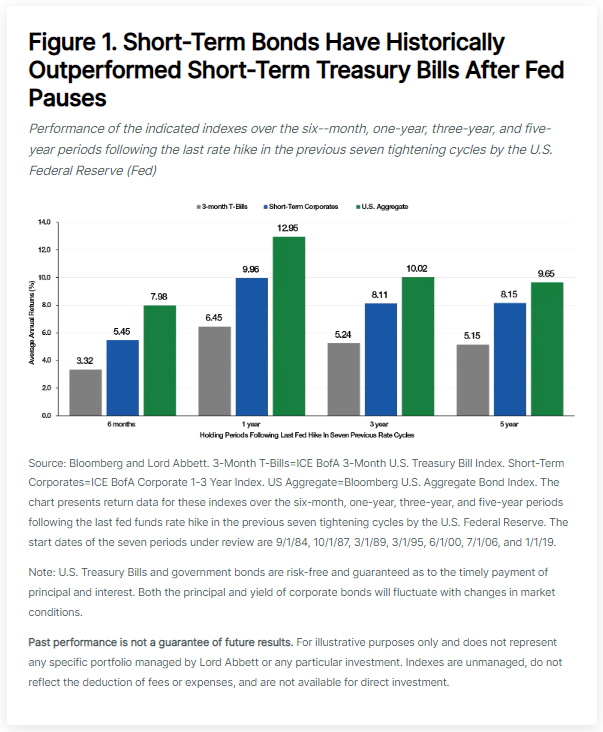
There are many variables to consider when determining fixed-income allocations, so for this study, we focused on just one: term. How far out should investors allocate along the curve? Before we address that question, let’s review today’s yield curve environment. Investors generally believe the Fed can slow the economy by raising its target fed funds rate, but prior experience shows a “soft landing” is a difficult outcome to achieve. Recessions have often followed previous cycles of the Fed aggressively increasing short-term interest rates, and yield curves usually invert, based on the expectation that short-term rates will have to come down in the future. That’s exactly what’s happening today, as shown in Figure 2.
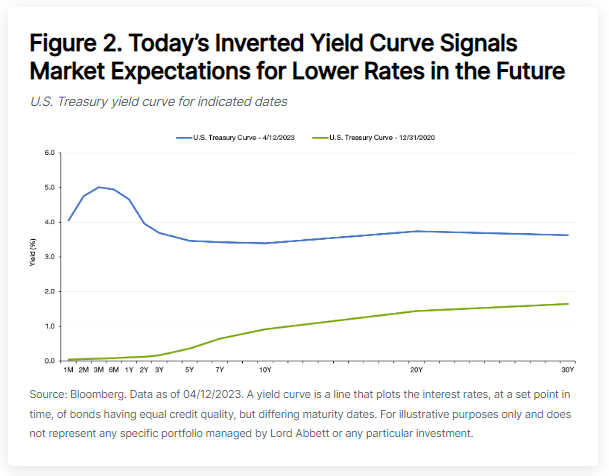
Analysis of Inverted Yield Curve Regimes
The idea of allocating to longer-term fixed income as we near a possible U.S. recession has merit, as rates typically decline in a recession. But today’s yield curve is already priced for the Fed to cut rates as early as late 2023, an expectation that is at odds with the Fed’s own projections.
To help answer the question of where to allocate on the curve today, we studied the historical performance of fixed income when the two-year to 10-year part of the yield curve was inverted for the prior 90 days. We compared popular short-term bond indexes—specifically the ICE BofA 1-3 Year Corporate Index and the Bloomberg 1-3 Year Government/Credit Index versus the popular, longer-term options, the Bloomberg U.S. Corporate Bond Index, and the Bloomberg U.S. Aggregate Bond index.
Figure 3 shows the periods of inversion and the annualized performance of the indexes mentioned. We find that investors would have historically fared better by investing in shorter-term rather than longer-term instruments. This difference has historically been large. On average, short-term corporates have outperformed the full-duration Corporate index by 210 basis points (bps) per year, while the short-duration Government/Credit index has outperformed the full-duration Aggregate index by 120 bps per year. Further, the short-term indexes have had less variability of returns and consistently positive results in all inverted yield curve environments. This compares to the two negative return periods for the full-duration Corporate index and the Aggregate bond index.

This is likely surprising to many investors as it challenges the prevalent belief that extending duration is the optimal defense against recessions. We can offer a few explanations for this unexpected result:
- The first was already mentioned: expectations. An inverted yield curve is a result of the market pricing in short-term rates to come down in the future, limiting the benefit to longer-term portfolios when that actually happens. Inversions have often been a good indicator of prior recessions (though lead-time variability difficulty in establishing precisely when the inversion takes place gives some reason to doubt its predictive record) but that doesn’t mean longer-duration fixed income is necessarily the right allocation, since longer-duration assets have typically already moved ahead of the anticipated economic slowdown.
- A second consideration: carry usually wins. Put another way, the starting yield on any bond is a critical component of fixed-income returns and is a particularly important indicator of forward returns for short-term, fixed-income assets. In an inverted yield curve regime, short-term instruments by definition offer a higher carry, serving as a cushion against potential losses and providing a stable source of income in uncertain economic conditions.
- Finally, for the past several years we have written extensively about an anomaly in the pricing of short-term, fixed-income risk, particularly in credit. Like other low-risk anomalies, such as low beta and quality, the short-term credit anomaly exists because investors want to be rewarded for time and effort spent researching investment opportunities; thus, they tend to crowd into higher-beta, higher-risk sectors, including longer-term bonds, disadvantaging the pricing of those sectors. As a result of this mispricing, short-duration credit has consistently delivered higher risk-adjusted returns relative to their full-duration cohorts.
Analysis of Other Yield Curve Regimes
When yield curves are more favorably priced for term risk, such as in steep yield curve environments, we find that longer-term portfolios do add return, as shown in Figure 4.

Note that much of this outperformance occurs over long periods when the yield curve is steep, as defined by over 91 bps of yield difference between two- and 10-year Treasuries based on the average for the 47-year period under observation. A notable period of long-term bond outperformance started in late 2007 and is over a decade long, largely reflecting the Fed’s zero interest-rate policy. A time-weighted analysis of fixed-income returns will suffer from the dominance of this “ZIRP” regime. In more normal interest-rate environments, the advantage of short-term instruments is clear.
Figure 4 covers a lot of ground, but several historical outcomes are apparent:
- Overall, short-duration bonds have outperformed intermediate bonds.
- When the curve is inverted, short beats intermediate.
- When the curve is flat, short beats intermediate.
- When the curve is steep, longer-duration bonds win out.
- Short-term corporates have outperformed the Aggregate index (Agg) in flat and inverted periods and have matched the performance of the Agg during steep periods.
The added fact that short-duration bonds have posted this level of performance while historically featuring lower volatility (more on that below) enhances their appeal, in our view, and argues for their role as an important standing allocation to fixed-income portfolios.
How Short-Duration Bonds Can Reduce Volatility
The volatility experienced in longer-term, fixed-income instruments in 2022 was unacceptable for most investors. While today’s starting yields make a repeat unlikely, uncertainty about inflation and its effect on the yield curve is still high. Note in Figure 5 that the standard deviation of inflation expectations within the University of Michigan’s monthly survey is still at extreme levels and reflects a high degree of uncertainty in terms of the inflation outlook.
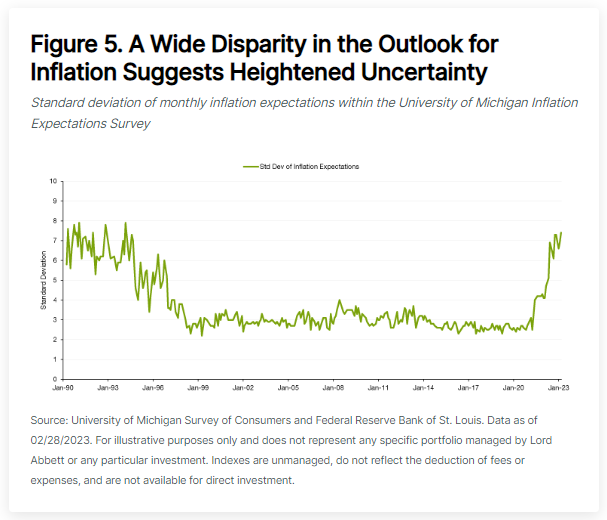
Including a substantial portion of short-term bond allocations in fixed-income portfolios can help with volatility reduction. Figure 6 shows the average annualized return of all the period studies in Figure 4 as well as the average volatility during those periods. Short-term instruments have a fraction of the volatility and are often more liquid, allowing for easier portfolio adjustments as conditions change.
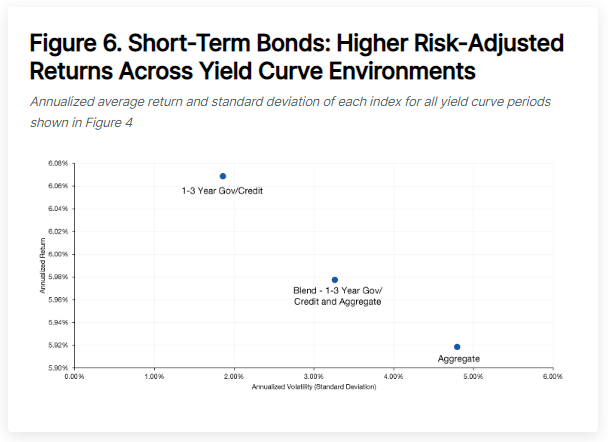
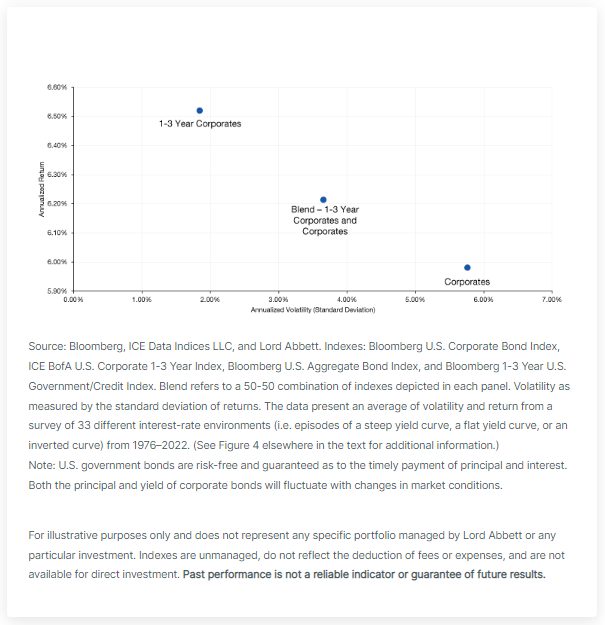
Takeaways
When considering fixed-income allocations today, the inverted yield curve environment is an important element of context. Even as investors prepare for a possible U.S. recession, the higher yields and limited rate risk of shorter-term instruments make them an attractive option in fixed-income portfolios. The historical record shows that short-term, fixed-income outperforms long-term bonds in inverted yield curve environments, with a fraction of the volatility.
Lord Abbett’s short-term, fixed-income mandates have a long history of active outperformance and have been used successfully as complements to longer-term allocations. This approach provides a more balanced and resilient investment strategy that can be adapted to various economic conditions and interest-rate environments.
As informações aqui contidas estão sendo fornecidas pela GAMA Investimentos (“Distribuidor”), na qualidade de distribuidora do site. O conteúdo deste documento [e informações neste site] contém informações proprietárias sobre LORD ABBETT e o Fundo. Nenhuma parte deste documento nem as informações proprietárias do LORD ABBETT ou DO Fundo aqui podem ser (i) copiadas, fotocopiadas ou duplicadas de qualquer forma por qualquer meio (ii) distribuídas sem o consentimento prévio por escrito do LORD ABBETT. Divulgações importantes estão incluídas ao longo deste documento e que devem ser utilizadas exclusivamente para fins de análise do LORD ABBETT e do Fundo. Este documento não pretende ser totalmente compreendido ou conter todas as informações que o destinatário possa desejar ao analisar o LORD ABBETT e o Fundo e/ou seus respectivos produtos gerenciados ou futuramente gerenciados. Este material não pode ser utilizado como base para qualquer decisão de investimento. O destinatário deve confiar exclusivamente nos documentos constitutivos de qualquer produto e em sua própria análise independente. Nem o LORD ABBETT nem o Fundo estão registrados ou licenciados no Brasil e o Fundo não está disponível para venda pública no Brasil. Embora a Gama e suas afiliadas acreditem que todas as informações aqui contidas sejam precisas, nenhuma delas faz qualquer declaração ou garantia quanto à conclusão ou necessidades dessas informações.
Essas informações podem conter declarações de previsões que envolvem riscos e incertezas; os resultados reais podem diferir materialmente de quaisquer expectativas, projeções ou previsões feitas ou inferidas em tais declarações de previsões. Portanto, os destinatários são advertidos a não depositar confiança indevida nessas declarações de previsões. As projeções e/ou valores futuros de investimentos não realizados dependerão, entre outros fatores, dos resultados operacionais futuros, do valor dos ativos e das condições de mercado no momento da alienação, restrições legais e contratuais à transferência que possam limitar a liquidez, quaisquer custos de transação e prazos e forma de venda, que podem diferir das premissas e circunstâncias em que se baseiam as perspectivas atuais, e muitas das quais são difíceis de prever. O desempenho passado não é indicativo de resultados futuros.

